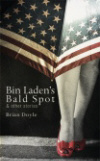Bin Laden’s Bald Spot & Other Stories
In this collection of twenty-five short stories, Brian Doyle takes his readers on a roller-coaster ride through social issues, politics, war, religion, mortality, and morality and shares his beliefs as an Irish, Catholic, devoted husband and father as openly here as he does in his nonfiction. Readers familiar with Doyle’s work will recognize the playful prose and rhythmic sentences, which the writer has tailored in tone and content to match each character’s persona, while a charming, unnamable oddness chuckles over the entire collection. Doyle doesn’t tell his readers what or how to think; rather, he simply asks us to follow him like the Pied Piper and watch as he drills down to the marrow of something, where he almost invariably finds a shred of hope.
In this collection of twenty-five short stories, Brian Doyle takes his readers on a roller-coaster ride through social issues, politics, war, religion, mortality, and morality and shares his beliefs as an Irish, Catholic, devoted husband and father as openly here as he does in his nonfiction. Readers familiar with Doyle’s work will recognize the playful prose and rhythmic sentences, which the writer has tailored in tone and content to match each character’s persona, while a charming, unnamable oddness chuckles over the entire collection. Doyle doesn’t tell his readers what or how to think; rather, he simply asks us to follow him like the Pied Piper and watch as he drills down to the marrow of something, where he almost invariably finds a shred of hope.
Most of these stories contain enough elements of truth or plausibility to be accepted as factual, but these elements are juxtaposed against enough improbability and obscurity to confirm them as fiction. In “The Train” the narrator has a heart attack on a train, and the first-person perspective pulls the reader into the man’s excruciating predicament. With each wave of pain and struggle to breathe, the man resorts to speaking in his native Gaelic. It’s no coincidence that Doyle’s Irish grandfather had a heart attack on a train, which Doyle has also written about in an essay.
The narrators enhance the tone of these stories, and they provide both the emotional connection to and distance from each one. In “Stay Flush,” the narrator recalls being paid to hear final testament of a customer at the golf club where he worked. Doyle sprinkles enough clues throughout to identify the customer as Joseph Kennedy, whose confession portrays him as a selfish, materialistic, unlikeable man. But the possibility of hope appears at the end, when the narrator imagines that the customer kept in touch with his brain-damaged daughter after that day on the golf course. “Pinching Bernie” reveals the fate of Bernard Cardinal Law after the Pope promoted him out of Boston and into the Vatican. The tough-guy narrator rekindles our anger and indignation here, reminding us of several of the infamous priests under Cardinal Law’s jurisdiction whose arrests for child sexual abuse made national headlines. According to the narrator, the former archbishop has been kidnapped and sentenced to scrub toilets for the victims’ families until “he has a heart attack and wins a date in hell with Mao and the boys.” We nod in agreement with the narrator’s conclusion that Bernie’s sentence seems “like the absolute best idea, you know what I’m saying?”
Several of the stories demonstrate Doyle’s writing style and use of humor, which he says “allows and opens a vein, sort of, and you can slip in the poignant dagger.” In the first and title story, Osama Bin Laden’s barber insists that Bin Laden has a bald spot shaped “amazingly like Iceland, complete with the Vestfjarda Peninsula to the west.” Inside the cave, the terrorists conduct a hilarious debate over the attributes of their favorite American movie actors while Osama orchestrates endless film productions in which he stars wearing a properly pre-rumpled camouflage jacket. Meanwhile, the barber daydreams of the day when justice will visit the cave and Osama will pay for his crimes. (Doyle wrote these stories before Bin Laden’s death.)
Some of the stories give reason to pause and ponder our own possible responses. In “Mule,” a young soldier is ordered by his sergeant to steal a mule that the sergeant plans to use in the execution of an enemy soldier, whose only “crime” seems to be his nationality. In “Blue,” some enlisted men are ordered to drown a comrade for being drunk on duty. And in “Yoda,” an elderly bachelor finds buried in his garden a newborn baby, whom he bathes, feeds, and rocks to sleep for two nights before returning her to her mother, the teenager who lives next door. The baby was born on Good Friday, “the saddest darkest day of the year,” and returned to her mother on Easter Sunday morning, and the associated notion of resurrection gives hope for the baby’s future. In “Lucy,” told in the third person, a man accidentally hits and kills a neighbor’s cat with his car, a hit-and-run. In the last paragraph, the narrator confesses—in first person, thus drawing us into his conscience—to keeping a memento of the incident for years.
I found these characters lingering like old friends long after I’d finished reading their stories. This collection would be a wonderful introduction to a reader unfamiliar with Doyle’s work. For Doyle devotees like me, the stories reaffirm his status as one of the finest storytellers and word wizards of our time, perhaps of all time.





